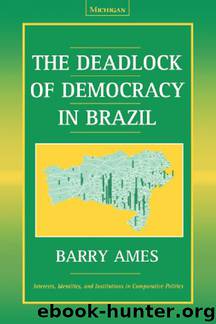The Deadlock of Democracy in Brazil by Ames Barry

Author:Ames, Barry
Language: eng
Format: epub
Publisher: University of Michigan Press
Cabinet Construction from Sarney to Cardoso
Do party and regional demands still predominate? Consider the cabinets of Tancredo Neves—who died before taking office—and José Sarney, the first civilian presidents following the military regime. The key economic ministers, from Rio de Janeiro and São Paulo, were appointed to reassure industrialists rather than provide pork. Neves gave the Ministry of Communications, which controls the highly political process of licensing radio and television stations, to Antônio Carlos Magalhães, the powerful Bahian leader. ACM, as demonstrated in chapter 4, had built a dominant state machine by dispensing federal projects to buy loyalties. As communications minister, however, ACM's influence extended to the national plane.
The Ministry of Transportation went first to a politician from Paraná, then to Sarney's fellow maranhense, José Reinaldo Tavares. Sarney had built his own career by delivering central government projects to Maranhão, especially roads and bridges, so Tavares's appointment furthered Sarney's postpresidential ambitions. Four different ministers ran the Education Ministry, but for almost the whole period the ministry was a fief for the bosses of Sarney's own Liberal Front Party (PFL). Health remained mainly in the hands of politicians from Bahia, the same state dominating the ministry between 1946 and 1964. This continuity was no accident: by 1986 the Bahian machine had long experience in distributing health-related pork.
At times President Sarney had to swallow painful appointments just to appease powerful state and congressional leaders. His first three ministers of welfare and social assistance, for example, were all political enemies, but the appointments satisfied PMDB congressional leader Ulysses Guimarães. Neves had appointed an economist (supported by the governor of São Paulo) to head the Planning Secretariat, but when this paulista departed, Sarney selected a little-known politician from Minas Gerais. Unfortunately, his new appointee seemed bent on converting the Planning Ministry into a conduit for social assistance programs that could help advance his own gubernatorial ambitions in Minas Gerais. After less than a year in office, corruption charges forced the minister to resign. Sarney then appointed a technocratically oriented economist, allowing Newton Cardoso, the governor of Minas Gerais, to make the actual choice. Since Cardoso was part of the historic opposition to Tancredo, the choice confirmed that President Sarney had broken away from his predecessor's base of support.
No single coalitional strategy, no single motivation except the recruitment of personally loyal followers, explains Fernando Collor's cabinet appointments. Consider the traditional spending ministries. Two former members of the Congress, early adherents to Collor's campaign but with little influence in the legislature, received the portfolios of education and health. Labor and social welfare went to a pro-Collor labor leader from São Paulo. An unknown from Alagoas (Collor's home state) ran social action, and a respected nonpartisan technocrat headed infrastructure. This mix of politicos and técnicos clearly does not reflect a focused attempt to maximize legislative support. Collor—unlike Sarney—preferred ministers with whom he was comfortable politically and personally, and he would have been hindered in any case by his weak party base.
Most of Collor's other ministerial appointments had little political clout.
Download
This site does not store any files on its server. We only index and link to content provided by other sites. Please contact the content providers to delete copyright contents if any and email us, we'll remove relevant links or contents immediately.
American Kingpin by Nick Bilton(3510)
Future Crimes by Marc Goodman(3374)
The Meaning of the Library by unknow(2386)
Inside the Middle East by Avi Melamed(2233)
Why Nations Fail: The Origins of Power, Prosperity, and Poverty by Daron Acemoglu & James Robinson(2176)
On Tyranny by Timothy Snyder(2127)
Living Silence in Burma by Christina Fink(1981)
Putin's Labyrinth(1902)
The Mastermind by Evan Ratliff(1830)
The Smartest Kids in the World by Amanda Ripley(1686)
Think Like a Rocket Scientist by Ozan Varol(1676)
Law: A Very Short Introduction by Raymond Wacks(1635)
It's Our Turn to Eat by Michela Wrong(1593)
The Rule of Law by Bingham Tom(1591)
Leadership by Doris Kearns Goodwin(1563)
A Dirty War by Anna Politkovskaya(1542)
Philosophy of law a very short introduction by Raymond Wacks(1541)
Social Media Law in a Nutshell by Ryan Garcia & Thaddeus A Hoffmeister(1451)
Civil Procedure (Aspen Casebooks) by Stephen C. Yeazell(1440)
